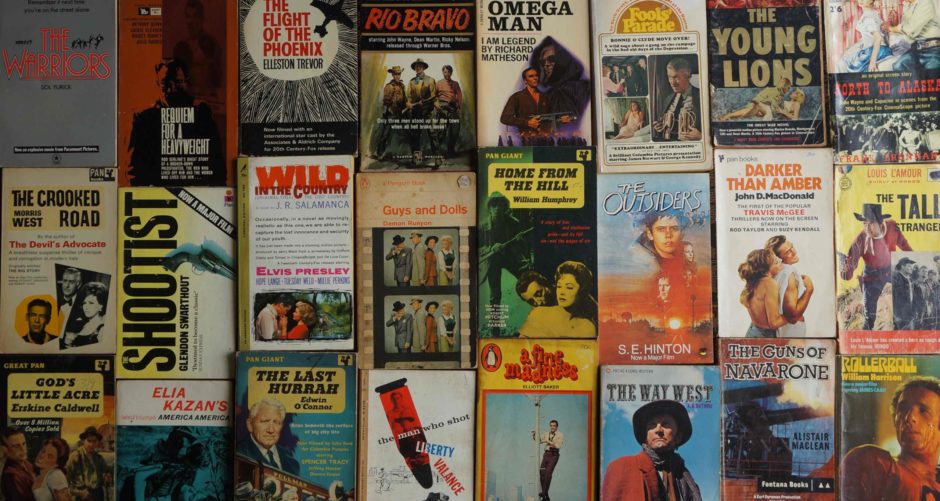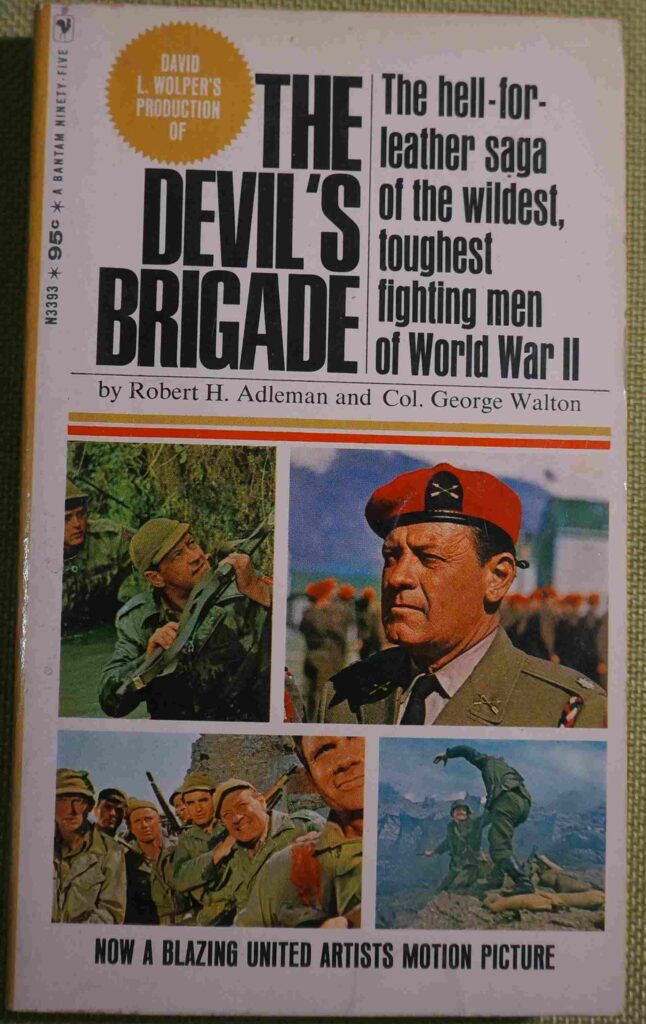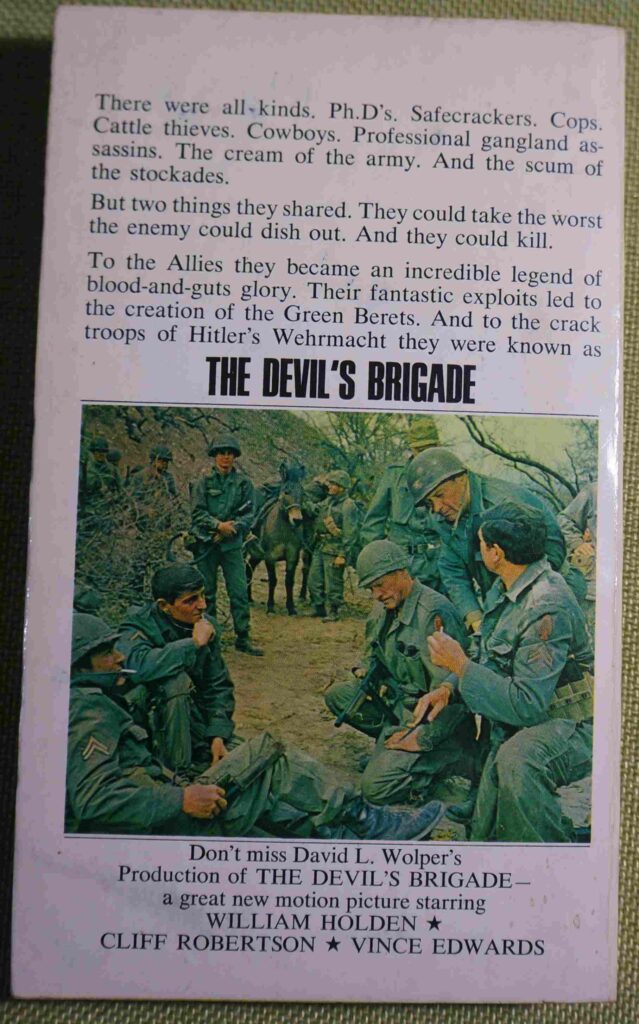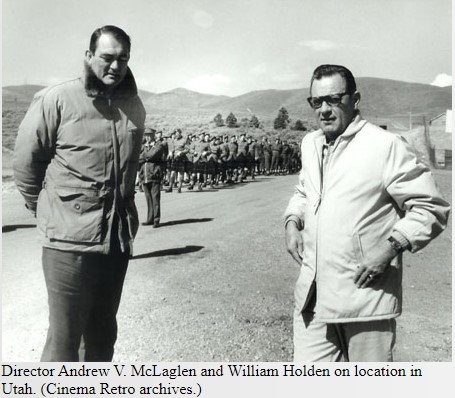FILM DIRECTOR: Andrew V. McLaglen
SCREENWRITER: William Roberts
FILM STARS: William Holden, Cliff Robertson, Vince Edwards, Andrew Prine, Jeremy Slate, Claude Akins, Jack Watson, Richard Jaeckel, Bill Fletcher, Richard Dawson, Tom Troupe, Luke Askew, Jean-Paul Vignon, Tom Stern, Harry Carey Jr., Michael Rennie, Carroll O’Connor, Dana Andrews, Gretchen Wyler, Patric Knowles, Wilhelm Von Homburg, Maggie Thrett, James Craig, Richard Simmons, Norman Alden.
COUNTRY: USA
THIS BOOK
AUTHOR: Robert H. Adleman and Col. George Walton
TYPE: Non Fiction
PUBLISHER: Bantam
THIS EDITION PUBLISHED: 1968
COUNTRY: USA
COVER: Paperback
THE ORIGINAL BOOK
ORIGINAL AUTHOR: As Above
YEAR FIRST PUBLISHED: 1966
ORIGINAL BOOK TITLE: The film title
NOTES
GENRE: War
WORDS: Hello Dirty Dozen.
Unfair but this comparison is often made between this film and The Dirty Dozen (1967).
E. M. Nathanson wrote the Novel The Dirty Dozen in 1965.
The Devil’s Brigade was based on a 1966 novel by (ex soldier) American novelist and historian Robert H. Adleman and (ex soldier) Col. George Walton, a member of the title brigade.
Both novels try to throw in authenticity though The Dirty Dozen’s mission is fictional and is clearly aimed more at escapism.
Both books were overshadowed by the film versions.
The Dirty Dozen directed by Robert Aldrich has become a classic whilst The Devil’s Brigade is largely forgotten by the mainstream though loved by war movie biffs.
It is often thought that The Devil’s Brigade (film) rips off The Dirty Dozen, and that may be the case though if it does it is the result of late re-writes. Brigade producer David L. Wolper bought the rights to The Devil’s Brigade in 1965, well before filming began on The Dirty Dozen. The Dirty Dozen was released in United States on June 15, 1967 having been filmed in England filmed Apr 25, 1966 – Oct 13, 1966 whilst The Devil’s Brigade was filmed in Utah and Santa Elia Fiume Rapido, Italy Apr 10, 1967 – Jul 3, 1967. The Dirty Dozen was an instant success so if the story of its rag tag misfits on mission was copied (or highlighted) for Devil’s Brigade it would have involved some frantic rewrites as Dirty Dozen was release only a month before shooting finished on Devil’s Brigade. Nothing is impossible in Hollywood though admittedly both original books deal with rag tag but violent soldiers trained for special forces or commando operations.
Either way Dirty came out first, is a better film, and has the cavalcade of future stars. It got the public’s attention.
Producer Wolper later wrote “The Devil’s Brigade turned out to be a terrific film. It was a wonderful story, the acting was excellent, and the preview audiences and critics loved it. Unfortunately it came out just a few months after the release of The Dirty Dozen, which was the same kind of story. It was a big hit and it killed us. We got lost in the wind.”
https://en.wikipedia.org/wiki/The_Devil%27s_Brigade_(film)
Coming out so soon after Dozen, Devil’s Brigade loses out though it’s not a bad film and the comparison isn’t wholly fair. The Devil’s Brigade has similarities to Dirty Dozen but it more serious and historically accurate, at least in its second half, making it a cross between Dirty Dozen and another mid 60s spectacular, The Battle of the Bulge (1965).
BIG war films were all the rage in the mid to late 60s
Here (the always wonderful) William Holden is put in charge of a unit called the 1st Special Service Force, composed of elite Canadian commandos (led by Cliff Robertson) and undisciplined American soldiers (led by Vince Edwards). The usual tensions in training are resolved as the men learn to become a fighting unit and do battle with the Germans in Italy (specifically an attack on the impregnable German mountain stronghold, Monte la Difensa).
The 1st Special Service Force (“The Devil’s Brigade”) existed and was highly decorated. The force was an elite American–Canadian commando unit in World War II, under the command of the United States Fifth Army. The unit was organized in 1942 and trained at Fort William Henry Harrison near Helena, Montana, in the United States (near the Canadian border). The Force served in the Aleutian Islands, and fought in Italy, and southern France before being disbanded in December 1944. However, to the veterans of the Force, the film was historically inaccurate suggesting there was never an aspect of The Dirty Dozen.
The non-fiction book reads a little like fiction, fictional non-fiction or non-fictional fiction? Real characters are given dramas drawn against real events. I’m not sure if it is engrossing though but there is detail.
The film, heightening the books themes, is a war film with all the usual men on a mission war movie tropes: a group of no-good Army hardcases and criminals “volunteer” for a suicidal assignment as an alternative to stiff sentences; a tough commanding officer oversees a semi-comic training period during where the men settle their difference and learn to work together as a unit; as preparation the group completes a smaller mission of skill to show their ability; the final is the blood-soaked mission which costs lots of lives (with many of the second leads dying heroically) before victory; the enemy, the Germans, are faceless and disposed off quickly.
It is what it is, and it’s fun, moving between the action adventure and “war is hell” themes.
Andrew V McLaglen, son of John Ford regular Victor McLaglen, had worked himself up from assistant director (on John Wayne produced films in the 50s) to a good action director. He is actually much underrated. Some of his gentler films are dabbed with John Ford themes (including the occasionally clumsy but still wonderful Shenandoah (1965)) but the big action films, including this one, show he can handle big casts and big action sequences (it’s harder than it looks) – The Wild Geese (1978), North Sea Hijack (1979), Breakthrough (1979), The Sea Wolves (1980) … and he did the same in many westerns The Way West (1967), Bandolero (1968), John Wayne’s The Undefeated (1969) and Chisum (1970), The Last Hard Men (1976) and many others. Interestingly he directed The Dirty Dozen: Next Mission (1985) a televison sequesl to the 1967 film.
The screenplay was written by William Roberts who co-wrote men on a mission westerns The Magnificent Seven (1960) and Red Sun (1971) as well as take the objective war film The Bridge at Remagen (1969). All classics in their own ways.
Holden is perfect – he seems to be aged beyond his years (he seems much older than 49 though the age is about right) and his usual casual cynicism movie persona he had been using since the early 1950s is in keeping with 1968 moods. Second leads, Cliff Robertson and Vince Edwards (always underrated and coming out of the successful TV series Ben Casey (1961-1966) are both sturdy and with Andrew Prine, Jeremy Slate (always snarky, always good), Claude Akins, Richard Jaeckel (who was also in Dirty Dozen, and should have been a star), Luke Askew, and Harry Carey Jr. in supports how can you go wrong? And, just like Dirty Dozen where there are officer big wigs who drop in and out of the plot providing cameos for well known actors (Robert Ryan, Ernest Borgnine, Robert Webber, and a less famous at the time George Kennedy), here Michael Rennie, Dana Andrews, Patric Knowles, and James Craig do similar cameos of authority.
Trivia:
The cast of The Devil’s Brigade included NFL running back Paul Hornung and World Middleweight Champion boxer Gene Fullmer in minor roles. They can be seen in the barroom brawl sequence, Hornung as a belligerent lumberjack and Fullmer as the bartender. Legendary NFL American football fullback, Jim Brown was in Dirty Dozen (in a largish role) – must have been a thing to drop sports stars into films (even if Jim did go o to have a reasonable film career).
Interestingly producer Wolper had the Brigade wear striking but fictional red berets that appeared as well as on the film’s posters and on the tie-in paperback cover of Adelman and Walton’s book.
Quentin Tarantino’s Inglorious Basterds (2009) features a character named Lt. Aldo Raine aka “Aldo the Apache” (in tribute to Aldo Ray) played by Brad Pitt who wears the Devil’s Brigade unit’s crossed arrows collar insignia and red arrowhead shoulder patch.
Watch the film … and perhaps, read the book if you want more back story.
LINKS
on set
TRAILER
The trailer seems to suggest that the action and adventure of peacetime are no comparison to war …





























yep re Kirk … no one pushes Kirk around. His Bryna Production Company was involved with (partially funded) POG ..and…